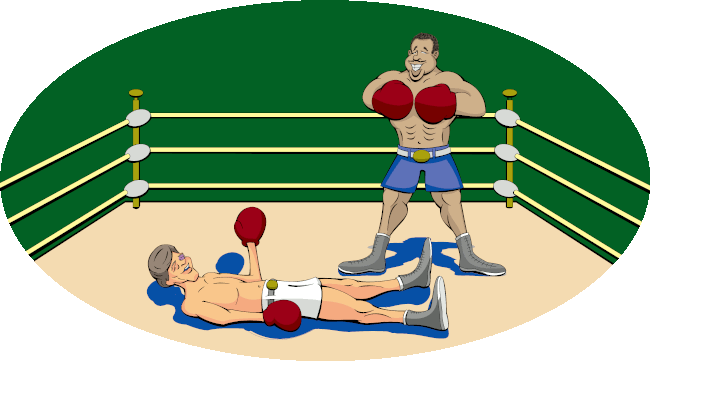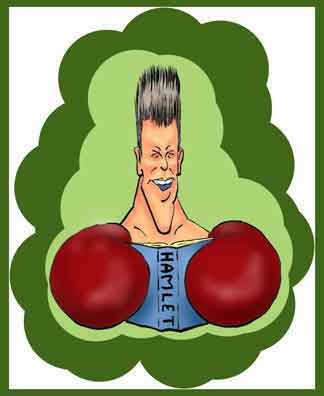Archie and George

(Click on the image to zoom in.)
Yes, four years before George Plimpton famously joined the training camp of the Detroit Lions as their temporary and last string quarterback (well described in his most popular book Paper Lion), he boxed three rounds with Archie Moore. Archie, for those not versant in the sweet science, was then the Light Heavyweight Champion of the World.
And yes, there is a bit of artistic license in the above rendering. Archie didn't actually knock George down. But George did take a couple of good punches and one of George's friends (who was there) said that one of Archie's jabs broke George's nose. In the end, George lost the bout on points.
In his career as literary editor, author, and professional amateur, George always liked to shoot for the top or the "essence" of whatever activity he was trying out. So to try his hand at boxing, why not start with the Heavyweight Champion of the World?
And that was Floyd Patterson. Except for the fact George had never boxed, the idea wasn't so far fetched. Floyd had just a few pounds on George - George was thin, yes, but tall (6'4") and tipped the scales at over 190 pounds. And someone in a lower weight class can legitimately fight someone in a higher division. So being technically a light heavyweight, George could properly take part in a full heavyweight fight.
However, knowledgeable advisors suggested George might want to stick in his own weight class rather than "fight-up" as it's called. Also Floyd was known as a serious person and might not want to be part of what would be an exhibition match of which he would likely win in a single punch.
On the other hand, Archie Moore, then the light heavyweight champion, was known as a friendly outgoing competitor. So George wrote Archie asking if they could have a match. Archie wrote back promptly saying that would be fine.
In the late 1950's you had the weight classes most people know of. These were flyweight, bantamweight, featherweight, lightweight, welterweight, middleweight, light heavyweight, and heavyweight. What's confusing is that some articles have gaps between the weight ranges. For instance you'll see the light heavyweight covers 158-175 pounds but then heavyweight starts at 200 pounds and on up.
So what if you weight 176 to 199 pounds?
Well, the confusion of the gaps is probably because the articles are citing modern weight classes but leaving out the more recent divisions. List everything and you'll find the gaps have closed, and the number of divisions has multiplied to levels that even some boxing fans think are too plethorical. Now we have strawweight, light flyweight, flyweight, super flyweight, bantamweight, super bantamweight, featherweight, super featherweight, lightweight, light welterweight, welterweight, light middleweight, middleweight, super middleweight, light heavyweight, cruiserweight, bridgerweight, and (finally) heavyweight with a superper heavyweight division sometimes tacked on.
George and Archie held the bout in Stillman's Gym which was run by Lou Stillman. Lou's real name was Lou Ingber, and we have to admit it. "Ingber's Gym" just doesn't cut it.
In 1959,1 Stillman's Gym was THE place in New York City for boxers, whether aspiring, amateur, or professional, and even today retains a dubiously legendary status. In addition to boxers, there were also people who would pay the entrance fee - 15¢ or 25¢ depending on the era - just to watch the big names who trained there: Jersey Joe Walcott, Jack Dempsey, Primo Carnera, Sugar Ray Robinson, Willie Pep, Georges Carpentier, Rocky Graziano, and many others. One boxer notably absent was Gene Tunney who objected to the less than stellar sanitation in a gym whose floors were never swept, the windows never opened, and that had only one shower.
Footnote
The exact date of the Archie vs. George fight seems a bit hard to pin down. Most articles give the year as 1959 but not exactly when. However, a friend of George's who was one of his corner men said it was six weeks after Archie's fight with Yvon Durelle in 1958. That was on December 10. Six weeks after that would be mid-January, 1959.

Jack Dempsey
He worked out at Stillman's.

Gene Tunney
He stayed away.
But another attraction for the general public was to see the celebrities who came, not to box, but also to watch and rub elbows with the famous pugilists. So at Stillman's you might see the likes of Frank Sinatra, Dean Martin, Jerry Lewis, and Tony Bennett just hanging around.
George decided before he met Archie he needed to find a professional trainer and so he contacted the owner of another gym, George Brown. The first thing Brown did was get George to stop smoking his usual two to three packs of cigarettes a day. George never returned to smoking and he said that there was no better reason to quit than fighting a world class boxing champion.
Much of George's training was not actually boxing. He'd start each day with a run in Central Park, then he'd lift weights mostly to condition the stomach muscles to take the punches. Then he'd work out on the heavy and light bags and then end the day with a sparring session. The latter exercises would go for three minutes which was the length of a round. Three minutes, George said, seems like a long time when it's occupied by throwing and sometimes taking punches.
The gym was packed for the fight and George managed to end the match with a bloody and broken nose but otherwise intact. He was well aware that Archie had not fought at his maximum. But he wasn't aware that the last round was a minute short because George Brown had surreptitiously advanced the clock.
Even today Archie is rated as one of the greatest fighters of all time although as a light heavyweight he didn't capture the headlines the way a Joe Louis or a Muhammad Ali did. But he was a frequent figure on television and did pretty well as an actor (his most memorable role was as Jim in the 1960 motion picture Huckleberry Finn). Archie fared well after his retirement - not always the case with former fighters - and became involved in civil rights and charitable and philanthropic activities.
George's sports endeavors went beyond boxing and football and included baseball, basketball, golf, automobile racing, and hockey. Although George's fame is mostly as a writer, he also bowed to the inevitable and took his professional amateurism to television. A number of TV specials brought George's activities well beyond sports and viewers saw George playing the triangle in the New York Philharmonic, appearing as a stand-up comedian in Las Vegas, performing as a circus trapeze artist, and being an extra in the John Wayne movie, Rio Lobo.
George played a gunman who was part of a corrupt posse that came to arrest a woman (played by Jennifer O'Neill) whose only crime was reporting that George's boss had her employer murdered. But when the posse comes into the saloon where she's sitting with the good guys - the county sheriff and John Wayne - she sees it's led by the murderer himself.
When the sheriff - played by Bill Williams - demands to see a warrant, George slips into the room through a back door and comes in behind where John Wayne is sitting. With gun drawn, George delivers his one line.
"I got a warrant right here, Sheriff."
Of course, in the shootout that follows, the good guys win.
References and Further Reading
"The Bout: When George Plimpton, the Boyish Editor of The Paris Review, Went Three Rrounds with the Light-Heavyweight Champion of the World", Blair Fuller, The American Scholar, June 1, 2008.
"George Plimpton Writer/Athlete", Sports Illustrated, August 3, 2007.
Shadowbox, George Plimpton, Putnam, 1977.
"Shadow Box, A Second Look At An Amateur In The Ring", Bobby Franklin, Boxing Over Broadway, July 11, 2016.
"George Plimpton vs. Archie Moore", Robert Ecksel, The Sweet Science, April 14, 2005,
Paper Lion, George Plimpton, Harper & Row, 1965.
"How Do Weight Classes Work in Boxing?", Alexander Netherton, DAZN Boxing, December 27, 2021.
"Boxing's Confusing Weight Divisions", Karl Freitag, Boxing News, November 11, 2020.
"Stillman’s Gym: The Center of the Boxing Universe", Joe Rein, Mr. Bellers' Neighborhood, June 1, 2003.
"George Plimpton", Internet Movie Data Base.